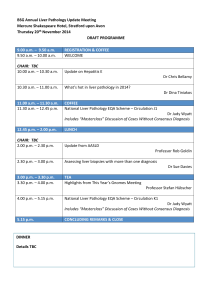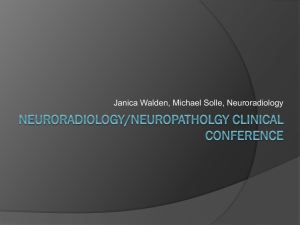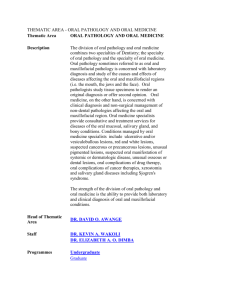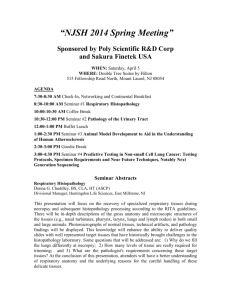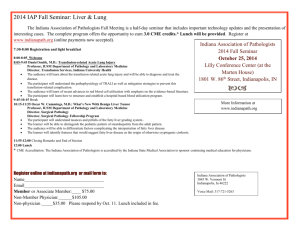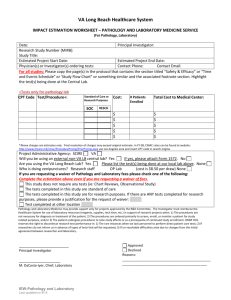Guide for Practices of Pathology
advertisement
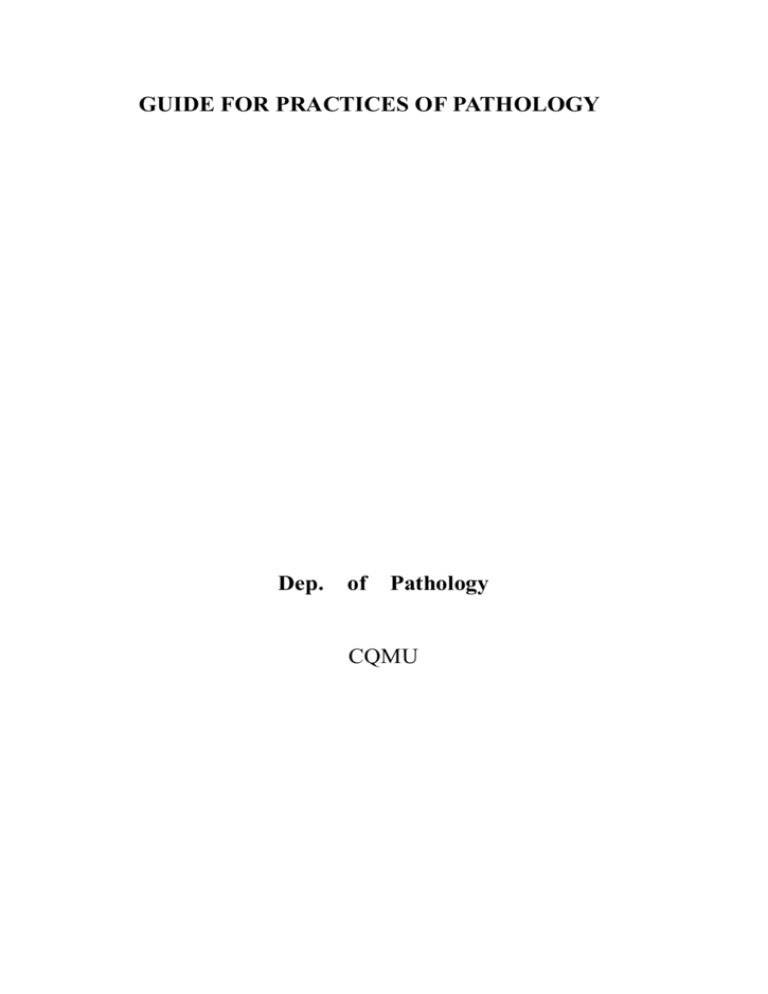
GUIDE FOR PRACTICES OF PATHOLOGY Dep. of Pathology CQMU GUIDE FOR PRACTICES OF PATHOLOGY PREFACE TO THIS GUIDANCE The guidance in this volume is written for the class of practice teaching. This syllabus is in two parts: the gross specimens and slides with a brief description on each. They will be to guide your study. Before starting the program, we should know: WHAT IS PATHOLOGY? Pathology is a branch of medicine that treats of the essential nature of disease, especially of the structural and functional changes in tissues and organs of the body, which cause or are caused by disease. So "Pathology is the study of the nature of disease." (W.A.D. Anderson) or "Pathology is the study of the tissue and products of the body in diseases.” are defined. Pathology is a broad subject. The above discussion concerns the part designated "anatomic pathology", which includes postmortem observations and surgical pathology, the study of tissues removed from living patients. For the proper studying of pathology, we should have a good grasp of the etiology(causes), the definition of the lesion (A "lesion" is defined as any abnormality of body tissue), the description of its gross (unaided eye), and microscopic appearance(any magnification up to electron microscope), the pathogenesis and the consequences of the disease. The first five chapters deal with lesions of various types, including tissue and cell injury, repair and adaptation, circulatory disorders, inflammation and tumors. They will be devoted to general pathology. After general pathology comes special pathology or systemic pathology, in which lesions are grouped by organ systems: Cardiovascular system, Respiratory system, Digestive system, Urinary system, etc. HOW TO LEARN FROM GROSS SPECIMENS During the laboratory time, a cartload of gross specimens will be brought to you and the instructor will discuss them with you. The descriptions in the syllabus will help you in studying gross specimens. Again you should ask yourself: What tissue or organ is this? What are the orientation, shape, color, size and consistency of the tissue or organ? What lesion is shown? What is its location, extent, size, shape and texture etc.; Can I visualize the microscopic appearance of this lesion? What caused the lesion shown here? What were the stages in pathogenesis of this lesion? What were the consequences of this lesion? What other related lesions might this patient have? Prevention? WHAT IS THE PROCEDURE TO DEAL WITH AND HOW TO LEARN FROM A SLIDE ? When you read microscopic slides, you should take the following steps: Hold the slide up and look at it with the unaided eyes first. This procedure is an important aid in orientation and locating important fields to be studied microscopically such as a necrotic area, a localized tumor or an area of hemorrhage. This step might give you a coarse impression of features of the lesion shape, size, tinctorial variation, defects or changes in tissue. Take out one eye piece, reverse it, hold its top lens against the slide, and get your eye close to the other end. This will give you a 10× view and will reveal many features of value. SECTION SIDE IS UP: Otherwise, when you go to high magnification, you will not be able to focus and will tend to force down the lens and crack the slide. Every slide costs few, but the tissue taken from the patients can not be evaluated by cost, and if the slide or lens is destroyed, you should pay extra fee. Low magnification (8-10× objective) is the most important power to survey the slide and to examine every bit of the tissue. You should learn to identify tissues, types of exudate and tumors at this power. The high dry power (40-50× objective) is sufficient to study most detail such as cell types or interstitial substances. To understand slides, ask yourself: What tissue is this (may be more than one)? What are the lesions (often more than one)? Have I missed any features? How did this lesion develop? What cause it? What would occur here in the future? What other related lesion(s) would this patient have? How could the lesion(s) here have been prevented? Can I visualize the gross appearance of this lesion? In order to learn rapidly from a slide it is important to know what one look for. Hence it is almost essential to have at hand a textbook which includes microscopic detail and which can be consulted before or during the study of a slide. It is of equal importance to make some notation of what one has observed on each slide. This may be in the form of a description as above, a brief outline, or a semidiagrammatic labeled sketch. As a preliminary step to any of these notes, it may be of help to make a list of the changes in the order observed. To gain an appreciation of the microscopic findings in terms of their functional significance, the true objective of morphological study, it should become a habit to question the meaning of what is seen, but the student should attempt to answer such questions himself before consulting an instructor. Students in the laboratory should obey the rules and finish the report seriously. HOW TO DESCRIBE A SPECIMEN The importance of learning to write a description in pathology as well as in any other branch of medicine is to enable the reader to visualize a lesion as the observer saw it without being influenced by the observer's interpretation of its nature. In order to best achieve this end, one should be accurate, systemic, and as brief as possible with emphasis on the pertinent abnormal findings. Avoid the use of diagnostic terms unless they are followed by objective descriptions, which justify their use. It is suggested that the student follow where possible and anatomic order to prevent errors of omission, but it is urged that he develop his own technique of expression. The description might proceed as follows: The name of organ or tissue, e.g., lung, heart, kidney. The name of organ or tissue, e.g., normal, greatly altered, etc. Grossly visible, localized lesions situation, extent, size, shape, etc. e.g., "in the cortex of the kidney there is a sharply circumscribed pale staining, triangular area, the apex of which extends into the medulla. It measures about 8mm on its base, and 6mm in height". Such localized areas may now be described in further detail. If no localized lesions are present, proceed with the general examination. Surface of the organ condition of the capsule, etc. If the normal surface covering is absent, state so; this will assure the reader that you looked for it. In hollow organs as heart, stomach, etc. both surfaces should be examined. Parenchymatous cells of the tissue. Note their arrangement, size, shape, staining reaction, foreign contents, etc. Condition of framework, i.e., the stroma. Is it normal? Is it normally or abnormally cellular? What kinds of cells are present? Is there any foreign material? Condition of blood and lymph vessel walls and contents of arteries, veins, capillaries, lymphatics. In the case of tumors, the description should answer the following questions. What is the evidence that it is a neoplasm? What is the evidence for a specific tissue of origin? Is it benign or malignant? Wang Shunhe PRACTICE 1 HEMODYNAMIC DISORDOR PURPOSE To master the causes, morphological changes and results of congestion of liver and lungs. the morphological features of thrombus, the causes of thrombosis and its possible results. the conception and the types of embolism, as well as its effects on human body. the conception of infarct and the morphological changes of ischemic infarct and hemorrhagic infarct. To be familiar with the morphological characteristics of hyaline thrombus. CONTENTS GROSS SPECIMENS 1. 2. 3. 4. 5. 6. 7. Chronic congestion of liver Chronic congestion of lung Mixed thrombus Embolism of pulmonary artery Anemic infarct of the spleen Anemic infarct of the kidney Infarct of brain 8. 9. 10. 11. Hemorrhagic infarct of lung Hemorrhagic infarct of intestine Acute appenditis Hemorrhage of lung SECTIONS 1. 2. 3. 4. 5. 6. Chronic congestion of liver Acute congestion of lung Chronic congestion of lung Mixed thrombus Anemic infarct of kidney Hemorrhagic infarct of lung GROSS SPECIMENS 1. Chronic congestion of liver (nutmeg liver) The liver is slightly enlarged with tense and smooth capsule. Note the dark red and yellow figures on the cut surface. The dark specks are the congested central veins and sinusoids of hepatic lobules. Since the blood leaves the lobule from central vein into intercalated vein, thus, the congestion is much serious in the central part of hepatic lobules. The yellowish areas are due to the liver cells undergoing fatty degeneration. The appearance of such congested liver is called "nutmeg liver". 2. Chronic congestion of lungs Some black or brown spots can be seen beneath the smooth and translucent pleura. On cut surface, the brownish congested lungs are firmer and denser than normal lungs. In case of chronically congested lungs, the erythrocytes may escape into alveolar cavities and then, they are engulfed by macrophages. Hemosiderin is formed from the breaking of hemoglobin within the
